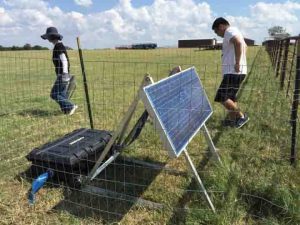
A University of Oklahoma geophysics professor, Xiaowei Chen, details the foreshock activities leading up to the Pawnee earthquake, and highlights the complicated relationship between seismicity and wastewater injection rates in a research study published this week in Scientific Reports. The study details the precursory earthquake (foreshock) sequences that culminated in the September 3, 2016, 5.8 magnitude earthquake near Pawnee, Oklahoma, which ruptured along the previously unmapped Sooner Lake Fault.
“In this study, we sought to better understand the nucleation processes of large earthquakes in Oklahoma, with the focus on the triggering process of the Pawnee earthquake. We began with an overview of occurrence patterns of earthquakes in Oklahoma, and their relationship with injection zones. Then, we focused on Pawnee County with a detailed analysis of the relationship between injection and precursory activities, as well as stress interactions between magnitude 3 plus foreshocks and the mainshock,” Chen said.
Chen, a professor in the OU School of Geology and Geophysics, led the study and collaborated with Nori Nakata, OU geophysics professor; Colin Pennington and Jackson Haffener, OU graduate students; Jefferson Chang and Jacob Walter, Oklahoma Geological Survey researchers; as well as collaborators Zhongwen Zhan, Caltech; and Sidao Ni and Xiaohui He, China. The study suggests that the Pawnee earthquake was a result of a complicated interplay among wastewater injection, faults and prior earthquakes in the region.
Within the broader Pawnee area, increased seismic activities started in 2014, but only until May 2016 did researchers detect microearthquakes in the immediate vicinity of the Pawnee magnitude 5.8 epicenter. The foreshocks from May to September 2016 occurred in two major episodes, and the seismicity rate correlates with wastewater injection rates from nearby wells. The pattern of foreshocks also reveals possible aseismic (or slow) slip near where the magnitude 5.8 occurred, which appears to drive foreshocks to “migrate” along the Sooner Lake Fault. Additionally, the three largest foreshocks were optimally-oriented so that their slip may have promoted failure along the Sooner Lake Fault.
Reference:
Xiaowei Chen, Nori Nakata, Colin Pennington, Jackson Haffener, Jefferson C. Chang, Xiaohui He, Zhongwen Zhan, Sidao Ni, Jacob I. Walter. The Pawnee earthquake as a result of the interplay among injection, faults and foreshocks. Scientific Reports, 2017; 7 (1) DOI: 10.1038/s41598-017-04992-z
Note: The above post is reprinted from materials provided by University of Oklahoma.










